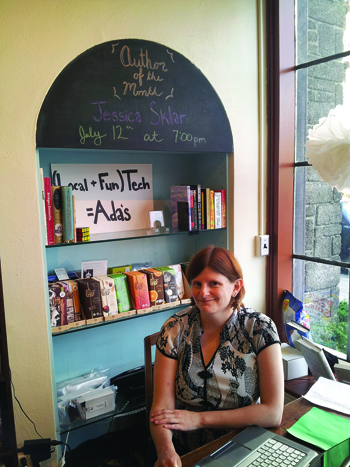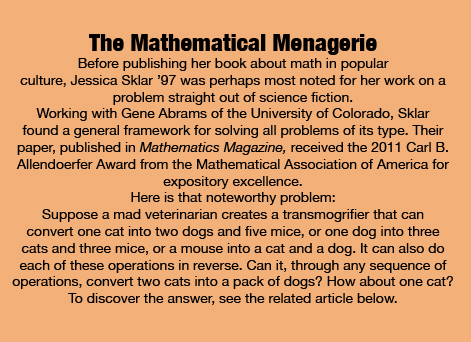1 Plus 1 Makes Engaging Book
Mother and Daughter Bridge Generations and Disciplines

Jessica Sklar ’97 was “shocked” when she won an award for a paper that originally had been rejected. “If you think you have something good, you have to put in the effort to listen to the criticism and make it better,” she says.
One was a math major at Swarthmore, the other was an English major. One of them is detail-oriented, the other likes to look at the big picture first. One teaches at an urban university in the middle of Detroit, the other at a tree-filled campus in suburban Tacoma, Wash.
But what Elizabeth Sherr Sklar ’63 and Jessica Sklar ’97 have in common is more important than what divides them. This year the dynamic mother-daughter duo became the proud co-editors of the new book Mathematics in Popular Culture. It’s a perfect blending of the talents of Elizabeth (an expert on the Arthurian legend in popular culture) and Jessica (who has written an award-winning paper on the whimsical Mad Veterinarian Problem—see sidebar).
When Elizabeth Sherr was still an undergraduate, she married Swarthmore professor Lawrence Sklar, who studied the philosophy of science. After earning a Ph.D. in English and medieval studies, Elizabeth accepted a tenure-track appointment at Wayne State University in Detroit, conveniently close to her husband’s job at the University of Michigan.
Jessica grew up influenced both by science and art. “I went to an arts high school called Interlochen Academy,” she says. “What I was really interested in was poetry. For me, at least, poetry and math have a lot in common: the focus on distilling things down to their essence, and the idea of rigor. The poetry I enjoy has the same sort of precision that math does.”
Jessica pulled off the difficult double major of English and mathematics at Swarthmore, then earned a doctorate at the University of Oregon. She now teaches at Pacific Lutheran University in Tacoma.
According to Jessica, the idea for the book came to her when she went to a conference of the Popular Culture Association with her mother. A horror-movies buff, she attended a session about Saw and realized, “I could write a paper on these movies as allegories of mathematical research.”
She had a sabbatical year coming up, and she knew Elizabeth had edited a book on King Arthur in popular culture. Why not a book on mathematics in popular culture? “I went to my mother and asked what she thought,” Jessica says. “She jumped on it right away.”
Says Elizabeth, “I thought, ‘Wow! What fun!’ ”

Elizabeth Sherr Sklar ’63, has done work on Arthurian legends.
Elizabeth became the main contact person with the publisher, while Jessica worked more with the articles. “Generally, she would start the editing,” Elizabeth says. “We discovered that it was a felicitous match between us. She’s a mathematician, so she is detail oriented. My way of reading things, whether an article or a student paper, is to start with a holistic reading and narrow down. When it came to wordsmithing, we were just gangbusters together.”
They didn’t have the least difficulty finding people to contribute articles. Jessica contacted some of her friends in mathematics, and Elizabeth spread the word among cultural theorists. Soon they were getting submissions from people they didn’t even know.
The result is an amazingly diverse book, both topically and in points of view. It includes several chapters on math in the movies: The Matrix, Andromeda Strain, Good Will Hunting, Stand and Deliver, and of course Jessica’s own chapter on Saw. Other chapters focus, for example, on literature (War and Peace, Cryptonomicon), television (Lost, Survivor), Web comics (XKCD), and games (baseball, Dungeons and Dragons).
Will they do it again? You can just about count on it. The two are already discussing a coffee-table book on mathematics and art. “I’d work with her again in a trice,” Elizabeth says.

 Email This Page
Email This Page